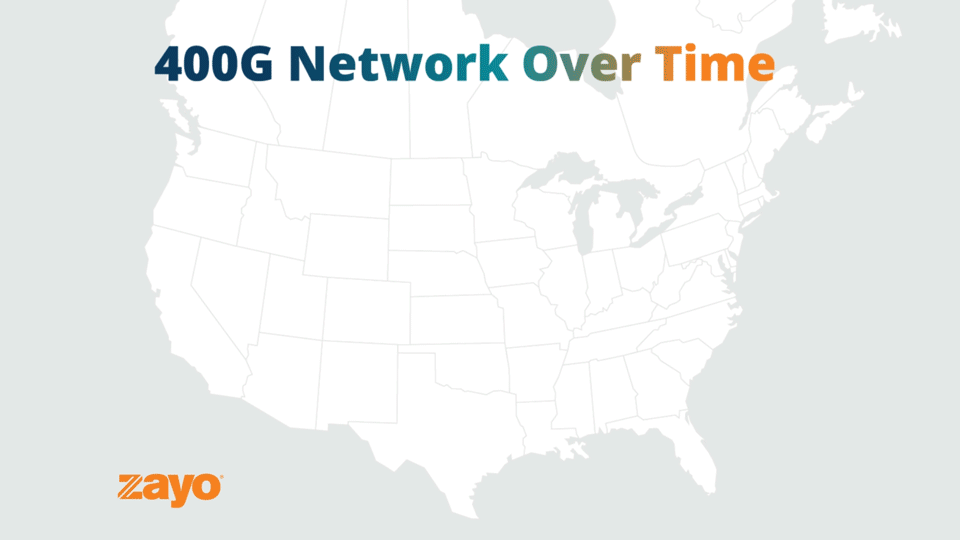Customers today increasingly demand real-time, data-driven services. To remain competitive and satisfy customers, organizations must take advantage of bandwidth-intensive applications like artificial intelligence, the Internet of Things (IoT), and advanced analytics. These applications require high bandwidth and low-latency connectivity to work optimally. Legacy infrastructure and small circuits simply can’t keep up with today’s demand.
Leading companies are investing accordingly. Since 2021, Zayo has offered 400G Wavelengths in addition to smaller bandwidth sizes on a number of routes – and we’ve seen an uptick in popularity for this level of capacity since we first introduced it. In 2024, 400G Wavelengths accounted for the most terabits (Tb) of wave capacity purchased by Zayo’s customers, according to Zayo’s recent Bandwidth Report.
Today, we’re proud to announce that our entire North American Wavelength network is 400G-enabled. Providing more bandwidth and faster speeds than previous iterations of fiber optic networks, 400G-enabled networks are poised to power the next generation of innovations, applications, and technologies.

Benefits of 400G Connectivity
Quadruple the capacity of their 100G predecessors, 400G fiber optic networks allow enterprises to scale their bandwidth as their needs increase, transfer data faster, and take advantage of the latest technologies, often at a reduced cost-per-bit. Today, Zayo supports optical 400G technology from Ciena, Nokia, and Infinera.
Scalability
There’s no telling exactly what the future of technology holds but we do know this – applications of the future will likely require a lot of bandwidth. We’ve seen explosive growth in bandwidth purchases from our customers as they take on bandwidth-intensive technologies and prepare for what’s next, including a 2.8x increase in total wavelength capacity purchased from 2020 to 2024.
Companies not yet tapping into the wealth of data at their fingertips likely will soon to keep up with the competition and innovate – and they’ll need enough bandwidth to be able to do so.
400G Waves offer the bandwidth you need today and the scalability to meet tomorrow’s demands. A 400G-enabled network reduces handoffs, minimizes failure points, and simplifies monitoring for high-bandwidth services. Investing in larger capacity now avoids costly future upgrades and reduces cross-connect fees, keeping your network efficient and prepared for growth.
Low Latency
A 400G-enabled network not only gives you the bandwidth needed to take full advantage of big data, but it enables you to transfer data quickly and analyze it in real time. Real-time applications require low-latency network solutions and traditional, legacy network solutions just won’t cut it.
Aside from data analytics, higher-capacity cables enable other real-time applications like video conferencing, tracking and monitoring tools, department-specific dashboards, and live broadcasting to work seamlessly for better internal and external users.
High Capacity
Today’s organizations require more capacity to take advantage of the Cloud and cloud-based applications and support multiple internal and external users. Cloud computing and data-intensive applications require high-capacity networks to operate optimally. Plus, organizations increasingly need to support multiple internal and external users and devices accessing the network at one time – without compromising performance.
What’s more, media today requires greater capacity than ever – applications like 4K video and video streaming depend on smooth playback with minimal buffering for the highest-quality user experience. Transformative tools like machine learning, AI, and data processing all require higher-capacity connections to function, as well.
Who Needs 400G?
Any organization facing exponential growth in data, users, devices, and applications can future-proof its network and benefit from 400G. Forward-thinking organizations in any industry can benefit from 400G. Here are four examples of industries where organizations are successfully realizing the power of 400G today.
Data Centers
According to the Zayo Bandwidth Report, 45.6% of all data center wavelength purchases by capacity in 2024 were 400G. Data centers face growing pressures due to the rapid growth of AI and computing demand, and are adjusting their network stacks accordingly.
Leading data center providers are purchasing high-capacity wave solutions to support AI computing, hybrid cloud solutions, and GPUs. They need 400G wavelengths to power training AI models, real-time rendering for gaming and simulations, and large data transfers.
Hyperscalers
Some of the earliest and most enthusiastic adopters of 400G, the largest cloud service providers (CSPs) heavily rely on high-capacity data transfer. Quantum computing, edge computing, and AI model training further amplify the need for bandwidth capable of meeting the soaring demands of processing, storing, and transmitting massive data quantities.
High speed and high capacity aren’t just on the “wants” list for this group – their whole business is centered around data. That said, hyperscalers depend on their network provider to offer the high-bandwidth connectivity needed to accommodate increasing compute and customer demands and to boost their data transfer and storage capabilities.
400G capacity also enables hyperscalers to increase business. The more capacity they have, the more users they can service. Plus, a single 400G cable is more reliable, stable, and technologically advanced than four 100G cables.
Carriers
In the same vein, Internet service providers (ISPs) and telecommunications companies, too, are in the business of data. Satisfying their customers depends entirely on the speed and bandwidth they’re able to offer them. Using 400G capacity wavelengths allows carriers to provide their end users with the fast Internet connections they need to accommodate growing data requirements.
Furthermore, recent industry trends like the emergence of 6G networks and terrestrial and satellite alliances drive bandwidth demand even further. In 2024, 400G purchases accounted for over half of all Wavelength purchases by terabits of capacity for Zayo’s carrier customers.
Software and Tech Companies
Software and tech companies are purchasing the most 400G capacity when compared to other industries, with 82.15% of their Wavelength purchases in 2024 being 400G. Zayo’s customers in this industry purchase 400G Wavelengths to provide SaaS and cloud services, database management, content delivery networks (CDNs), and cybersecurity solutions. They rely on massive capacity to manage enterprise databases, perform real-time analytics, power video streaming, deliver data-intensive services, and maintain a leading edge in threat intelligence and proactive cybersecurity.
Zayo: Top 400G-Enabled Network Provider in North America
Zayo continues to commit to our customers by enhancing our modern, global network and extending our reach into new markets. Now, 100% of Zayo’s North American network is 400G-enabled. With a continued focus on what’s next, Zayo is helping to meet the increasing demand for bandwidth now and in the future.

